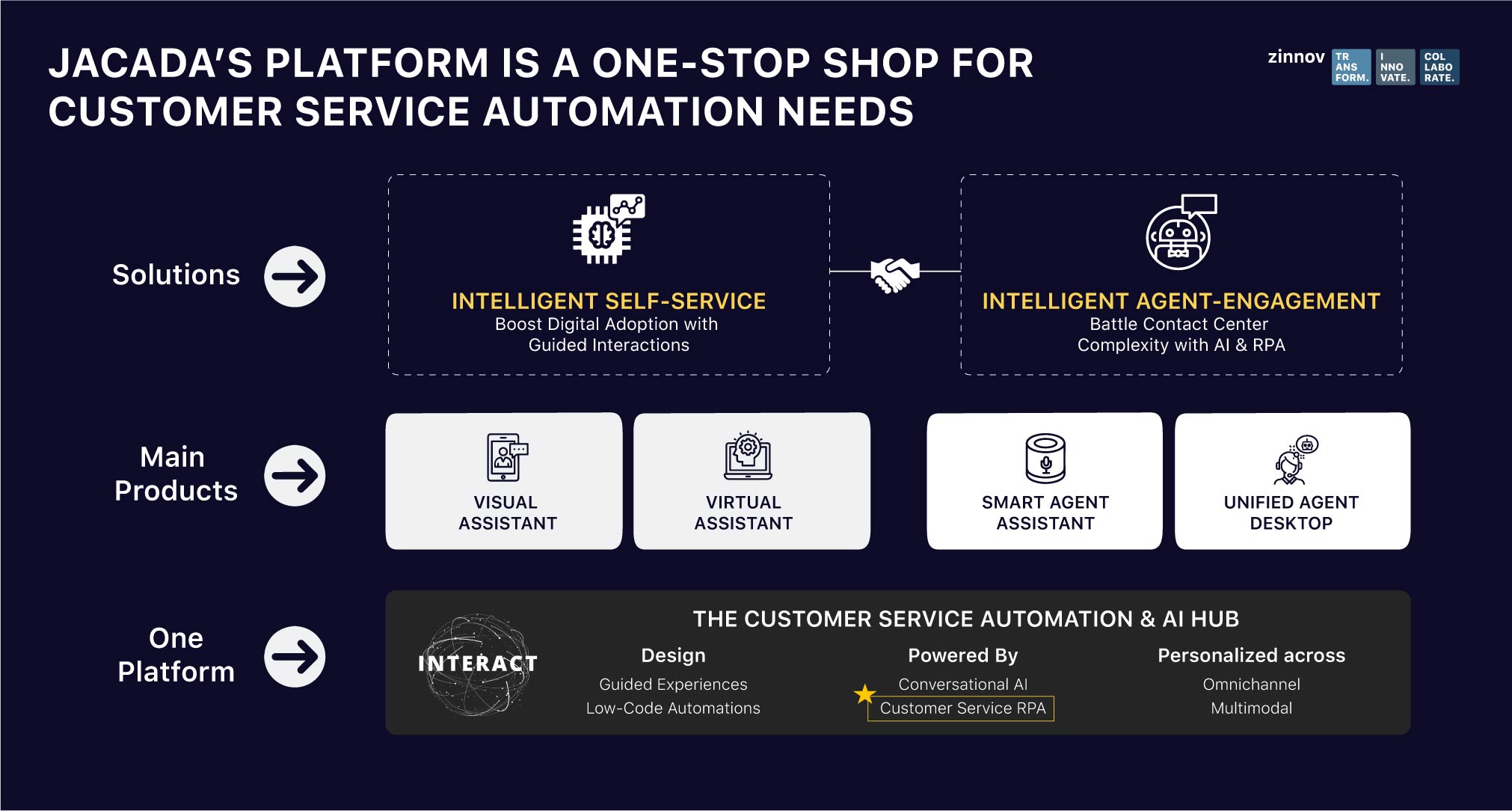|
|
Zinnov sits down with Scott Merritt of Jacada for an insightful, two-part interview on the current state, and future of RPA.
Did you know that enterprises spent more than $2.3 billion on RPA in FY19? And that this number is expected to grow exponentially by 35-40%, to reach more than $11 billion by 2024?
RPA and Intelligent Automation have not only become mainstream conversations but are being implemented across enterprises at a rapid pace. Further, with attended and unattended scenarios making visible inroads in enterprises’ automation journeys, there is a renewed focus on Intelligent Automation. Based on Zinnov’s research and analysis, we estimate that attended RPA (bots working together with humans) accounts for approximately 30% of the market share and is growing at a steady pace.
Given the attention that Intelligent Automation is receiving across companies, and irrespective of industry vertical, Nischay Mittal, Engagement Manager at Zinnov caught up with Scott Merritt, Vice President, Global Head of Automation and Marketing at Jacada, to gather his perspectives on the key trends within the RPA space, especially the growing focus on attended RPA and Customer Service Automation (CSA).

Merritt: One of the biggest trends that we are witnessing is customers struggling to understand what or where to automate next. Customers often get through the proof of concept (POC) stage, start accepting the technology as a viable part of their architecture, but they fail to go beyond those initial use cases and pilots. This challenge to scale RPA for early adopters has quickly accelerated the industry from say RPA 1.0 to RPA 2.0, which is bringing to light a much-needed focus on a broader “intelligent automation” toolset rather than just an RPA only bot operation.

As a result, RPA companies are investing in additional capabilities to expand their offerings in order to drive meaningful business outcomes instead of just delivering a somewhat commoditized back-office RPA bot that can navigate a UI on behalf of a user.
Another trend stemming from this scale gap in RPA is the growing focus on Attended RPA. Formerly known as “desktop automation”, Attended RPA is a 10+ year old automation approach that grew out of a need in the contact center to integrate non-API ready applications and automate the many manual microtasks that bog down agents during a call, impacting handle time and customer experience (CX). At Jacada, we often find two dozen or more solutions on the agent desktop and they are a combination of these API-ready and non-API ready legacy applications. Automating for this type of environment, however, requires a different type of discovery approach and supporting RPA framework, one that is built for human collaboration vs the one built for robots (unattended).



Merritt: There are many reasons but one I often site is “back office blinders” or too narrow a scope. Let me explain. The original entry point for RPA unattended vendors and SIs was to target high volume / low complexity processes that could be automated end-to-end in back office departments like IT, Finance, Accounting, HR, etc. While these groups do have a need for RPA, they don’t always represent the ideal use case environment for RPA… or at least not after the low hanging fruit is picked off during the first few projects. What you often find here are smaller departments of people working on many disparate, more complex tasks; which often require human discretion at some point in order to complete the process. For example, one regional bank I worked with in the past had 80 back office workers in their card services division working on 160 different exception-based processes in any given month. Going into this environment with an unattended RPA only approach, it’d be difficult to support an ROI that would justify the project but several companies like this bank have moved forward based on limited options and poor guidance. We are now a few years into this approach and over 50% of companies have deployed < 10 robots and haven’t scaled their RPA programs beyond their original list of projects. This represents a flawed RPA strategy at the foundation and unfortunately one that was pushed by many of the new players in the market along with many of the SIs.
To counter this misstep and open up new use cases for RPA, vendors are addressing the more complex back office use cases with add-on capabilities like OCR, ML, Computer Vision, etc. However, to unlock RPA’s full potential, you have to add Attended bot capabilities to your intelligent automation stack allowing you to expand into areas of the organization where a much higher volume of people and tasks exist. A strategy that often brings you to the customer service operations arena.
As some of the larger unattended players realized this new fertile ground, they pivoted strategy and began to market this new type of bot with “attended” and “customer service” banners flying on their websites. These vendors are quickly finding that successfully managing this automation triangle of Customer-Robot-Employee is very different (in approach and supporting RPA technology) than building automation solutions for robots.


Merritt: Jacada is a niche player in the RPA space but at the same time, I would argue that all RPA vendors are niche players based on their core use cases and technology strength. Jacada‘s niche targets end to end customer service interactions by focusing on human and robot collaboration use cases in both digital self-service and customer assisted service scenarios. We have a strategy and supporting technology stack that has been transforming customer interactions for almost 30 years now. The space is unique compared to back office RPA as it involves an additional layer of complexity which is that all automations involve real-time interactions with agents and/or customers. As a result, we go to market with a Collaboration-First approach where capabilities like UX design, conversational AI, guidance, and automations have to be designed and orchestrated together in order to deliver a successful solution at scale for both customers and agents. All capabilities that reside within our low code intelligent automation platform, a unique offering compared to other RPA players in this space who often have to bring together multiple technology partners to deliver this kind of end to end customer service value proposition.



Merritt: It all depends on how you define “complexity” quite honestly as process complexity can come in different forms when it comes to RPA.
Sometimes complexity is defined by the complex desktop environment that bots must navigate relative to the automation triangle I mentioned earlier. One of the exciting areas where we use AI to enhance RPA is in real-time speech to intent trigger. For example, when a customer calls a contact center, we leverage AI to power real-time speech analytics to orchestrate different bots throughout the live interaction. A speech bot can listen to the conversation and wait until a trained intent is recognized and then trigger a new guidance flow or bring back the answer to a customer question using Attended RPA without the agent having to touch the keyboard. This is a situation where a combined RPA and AI strategy can deliver on more complex use cases to enhance both the agent’s and customer’s experience.
Process complexity can also be defined by the complexity of the applications or application types that a bot needs to work with. Perhaps the number one challenge we see in the market is a result of a vendor platforms’ inability to integrate and automate with all of the necessary application types needed to automate the desired use cases. Known in the industry as “application coverage”, those vendors who lack broad and deep coverage of applications will require more investment in their RPA tech stack, not necessarily more AI to solve this problem. Unless of course, you include computer vision into the mix but that would be a different conversation altogether.
Another form of process complexity could come from the need to automate processes that involve converting unstructured data from forms or documents as a first step to automate a process end to end. Once again, the vendor would first need to have enhanced capabilities within their RPA platform to support OCR, computer vision, or other methods that can be used to access the unstructured text. When that is achieved, AI/ML can provide a more scalable way to identify and structure this data thereby removing a significant amount of human effort from the process.
Look, the future of AI within automation is exciting and all of us are focusing on R&D to further enhance our platforms with it. However, it is not always the best first choice when trying to solve for process complexity, despite what vendors may say to convince you. Very often I see organizations jumping too quickly into the AI vortex hoping for that quick fix before they have established a proper RPA foundation.


Merritt: Our focus is on bringing together the relevant customer service automation capabilities into a common intelligent automation platform in order to automate customer service interactions. This customer outcome-driven approach guides our investment in AI and other cognitive technology. Take Natural Language Processing (NLP/NLG) for example. Our use cases and supporting capabilities for conversational AI focus on leveraging intent and sentiment recognition to understand in real-time a customer request regardless of channel. To support these different use cases, we have developed in-house AI capabilities to enable automation design while offering an intelligent automation and AI hub that allows clients to use their own preferred conversational AI platform whether it’s Google, Facebook, Watson, or other best-in-class providers. This open AI platform approach offers our clients complete flexibility while at the same time provides a plug-and-play environment for them to tie the entire customers’ interactions together in one low code design environment.
This is similar but yet different from the AI investment approach you typically see in back office unattended RPA use cases which often target data structuring to automate things like a document or email processing. The point here is that every RPA platform provider is investing in some form of cognitive/AI/ML technology to expand the number and type of outcomes they can deliver to their customers. As a result, RPA buyers really have to understand what outcomes they are trying to achieve and select the right vendor(s) accordingly – if they are trying to match invoices by leveraging AI/ML, there might be a certain vendor path for them; if they are looking to understand intent and deploy a virtual assistant for employees, that might result in a different vendor selection. Today there is not one vendor who covers use cases across all verticals despite the vendor claims (going back to my point of view that all RPA vendors are niche players right now). I think it’s about finding the vendor who has the relevant expertise and experience to match the outcomes, use cases and application integration requirements as per the customer demand.

Zinnov: Thank you, Scott.
Even though it’s the new-age disruptive technologies that form the spine of any successful automation initiative, organizations often struggle with the implementation aspect of Customer Service Automation. Read the second part of this interview blog to get Scott’s insights on the challenges and key drivers of RPA implementation.